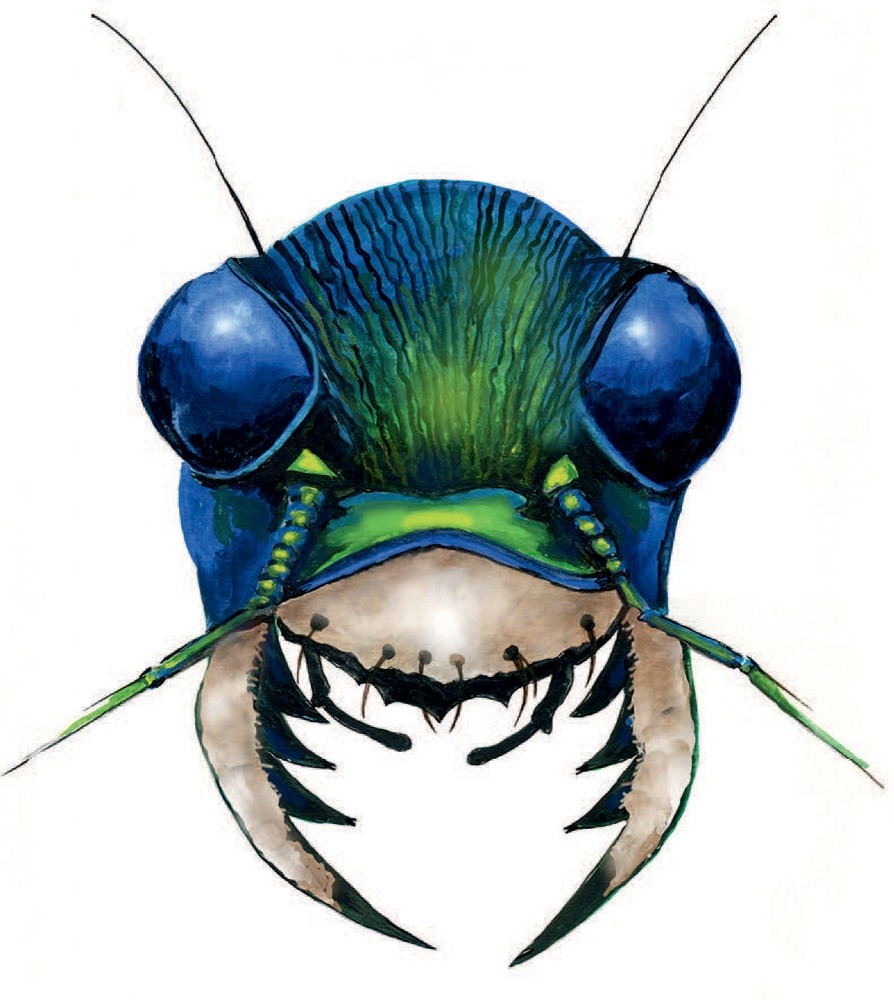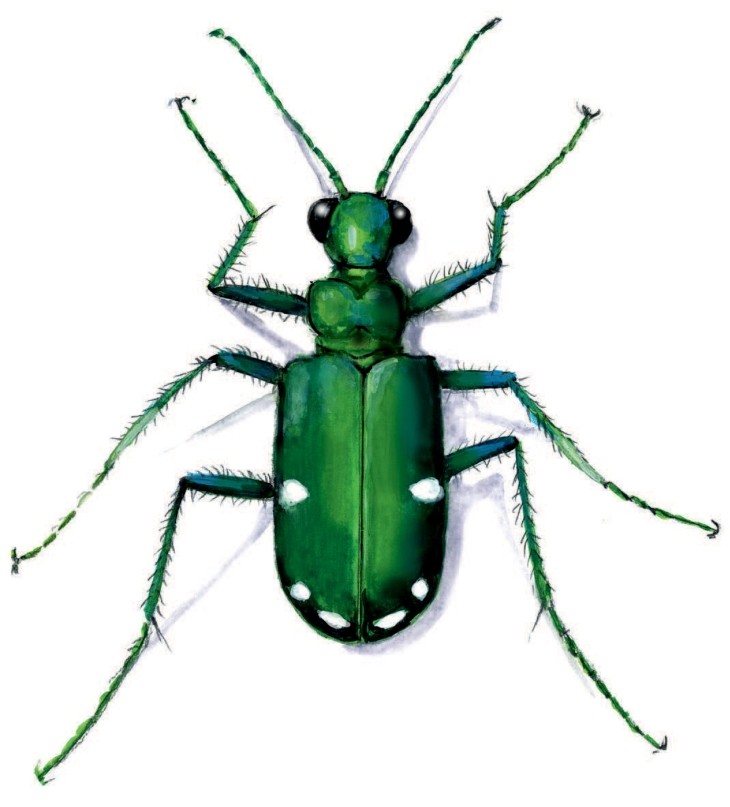
Many beetles are slow fliers and runners, but six-spotted tiger beetles (Cicindela sexguttata) are masters of speed. A metallic flash of green or sometimes blue may be your only glimpse of this species. If you are able to approach one, it will likely take flight before you’re close enough to count the six (sometimes fewer) spots on its wings. When the beetle lands, chances are it will be facing you, monitoring your movements, and ready to take flight again if warranted.
Although they often fly away from danger, tiger beetles hunt on the ground and predate a variety of insects and other invertebrates. These lanky-legged beetles achieve sprint speeds that leave all comers in the dust. For comparison, a cheetah running at 60 miles per hour covers an impressive 22 body lengths per second. Tiger beetles can cover 120 body lengths per second, making them the fastest sprinters ever recorded. For you or me to compete successfully in a scale-appropriate foot race with these six-legged wonders, we would have to muster the cruising speed of a passenger jet.
High-speed running has obvious advantages, but it can also result in momentary blindness. To understand why, imagine your view of passing scenery while sprinting to the grocery store – at 490 miles per hour. Now imagine that your “grocery store” doesn’t just sit there, but takes evasive action.
When a six-spotted tiger beetle loses sight of its prey, it stops, reorients, and continues pursuit. This stop-and-go approach would be a poor strategy for most predators, but tiger beetles can afford to pause for a fresh view because nothing food-size can outrun them.
Two other adaptations help six-spotted beetles cope with speed-blurred vision. One involves versatility in how they snare prey. In situations when the beetles can anticipate distance to prey, they will adjust when to snap closed their cartoonishly large and many-toothed mandibles. However, when blurred vision prevents them from anticipating the exact proximity of what they’re chasing, six-spotted tiger beetles may instead scoop up their prey midstride using a basketlike arrangement of mandibles and hairs and deliver a bite after they stop running and have time to assess their catch. Beetles repeatedly open and close their mandibles while running down prey, which makes me imagine a frantic gardener unwisely sprinting while using hedge trimmers.
The beetles, however, have also evolved a tactic for avoiding high-speed collisions. To return to the grocery store analogy, imagine your 490-mile-per-hour sprint to Price Chopper involved a route strewn with giant leaves, twigs, rocks, and other debris. Inevitably, you’d run into some of these materials during your blurry, hell-for-leather dash. The way tiger beetles avoid collisions, as demonstrated in experiments by Daniel Zurek and Cole Gilbert from Cornell University, is by pointing their flexible antennae forward and down-angle, like curb feelers on a hotrod. When their antennae detect objects, the beetles lift their front ends to avoid a crash.
Although six-spotted tiger beetles can live for several years, you’re less likely to see them from late summer through winter, when adults hunker down in leaf litter and under fallen logs. They emerge in forest habitats as early as late March, with peak abundance in May and June, when last year’s larvae emerge as young adults. As the season progresses and trees leaf out, your best chance to find the beetles is in sunny patches below canopy gaps or on forest edges, where solar heating allows them to easily maintain ideal body temperature. These sunny areas also attract other invertebrates, and six-spotted tiger beetles wait for them like lions by a water hole.
The beetles mate through summer, and females bury eggs one at a time in forest soils. The larvae are also impressive predators, although they rely solely on ambush tactics. Soon after hatching, a larva digs out a U-shaped tunnel and waits near the top of one end for small invertebrates to approach. The larva grabs its prey with its mandibles and drags it underground. Larvae feed, grow, and molt for about a year before pupating.
In recent years, with the arrival of emerald ash borer to our region, people will sometimes confuse six-spotted tiger beetles for the invasive pest. Some of my students at Saint Michael’s College have made this mistake, expressing concern that they have may have glimpsed emerald ash borers on campus trails. Given both insects’ metallic green color and similar size (each is approximately half an inch long), it is an understandable error. But emerald ash borers are far more likely to be up in the canopy, are less likely to take flight, and in our region don’t emerge from ash trees until late May or early June. So, during a springtime stroll, if you see a metallic green flash on the trail ahead, it’s most likely you’ve just witnessed one of our region’s fastest predators – and you should be very glad you’re not bite-sized.


